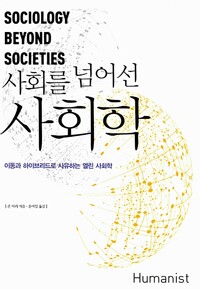
Sociology and complexity science: a new field of inquiry
- 발행사항
- New York : Springer, 2009
- 형태사항
- xx, 277 p. ; 24 cm
- ISBN
- 9783540884613
- 청구기호
- 331 C348s
- 서지주기
- Includes bibliographical references (p. 262-270) and indexes
소장정보
| 위치 | 등록번호 | 청구기호 / 출력 | 상태 | 반납예정일 |
|---|---|---|---|---|
이용 가능 (1) | ||||
| 1자료실 | 00013336 | 대출가능 | - | |
- 등록번호
- 00013336
- 상태/반납예정일
- 대출가능
- -
- 위치/청구기호(출력)
- 1자료실
책 소개
This book explores the basics and the latest in the integration of sociology and complexity science. It offers an array of real-life applications and showcases a new method for studying social complexity called the Social Systems Toolbox.
By now, most academics have heard something about the new science of complexity. In a manner reminiscent of Einstein and the last hundred years of physics, complexity science has captured the public imagination. ® One can go to Amazon. com and purchase books on complexification (Casti 1994), emergence (Holland 1998), small worlds (Barabasi 2003), the web of life (Capra 1996), fuzzy thinking (Kosko 1993), global c- plexity (Urry 2003) and the business of long-tails (Anderson 2006). Even television has incorporated the topics of complexity science. Crime shows ® ® such as 24 or CSI typically feature investigators using the latest advances in computational modeling to “simulate scenarios” or “data mine” all p- sible suspects?all of which is done before the crime takes place. The ® World Wide Web is another example. A simple search on Google. Com using the phrase “complexity science” gets close to a million hits! C- plexity science is ubiquitous. What most scholars do not realize, however, is the remarkable role sociologists are playing in this new science. C- sider the following examples. 0. 1 Sociologists in Complexity Science The first example comes from the new science of networks (Barabasi 2003). By now, most readers are familiar with the phenomena known as six-degrees of separation?the idea that, because most large networks are comprised of a significant number of non-random weak-ties, the nodes (e. g. , people, companies, etc.
New feature
This book is the first to identify and review the new field of study, sociology and complexity science?or SACS for short. SACS is comprised of five cutting-edge areas of research: computational sociology, the British-based School of Complexity (BBC), complex social network analysis (CSNA), sociocybernetics and the Luhmann School of Complexity (LSC). Together, these five areas represent the latest development in complexity science and sociological systems thinking, offering researchers a powerful, new set of tools for addressing the growing complexity of sociological inquiry.
This book also showcases a new method for modeling social systems, called the SACS Toolkit. The SACS Toolkit comes with a theoretical framework (social complexity theory), procedural algorithm (assemblage) and recommended toolset for modeling social systems (qualitatively, historically or numerically) from the ground-up. In fact, this book uses the SACS Toolkit to review the new field of SACS.
The third feature of this book is its compendium of maps, graphs and figures?all located in one chapter. Demonstrating the visual ingenuity of complexity science method, this compendium provides a picture-book tour of the new field of SACS.
Finally, this book comes with a companion website?an internet resource for exploring the new science of complexity and its intersection with sociology; and for downloading the maps (in color) used in this book. Useful for teachers, students and researchers, this book articulates a possible future for social scientific inquiry in the 21st century.
목차
Introduction.- SACS Toolkit - Theoretical Framework.- SACS Toolkit - Assemblage.- Overview of SACS.- Environmental Forces.- Five Areas of Research.- The System of SACS.- SACS Today.- Conclusion.- Mapping Complexity.



